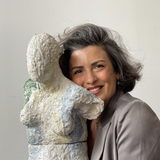Mud Break is a clay workshop hosted by visual artist Esra Sakir in New Metropolis Nieuw-West. Esra is an artist and in crafting her artistic narrative, she reflects on the profound connection between humanity and the environment, and the urgency to redefine our relationship with existence in the face of the challenges posed by the Anthropocene. Join her and discover more about clay and how to create various sample sculptures. In this session, we will work together and exchange ideas, messages, values and we will explore how to translate them into tangible shapes. The workshop will last three hours and all material will be provided by us. You can read more about the session in the Artist’s Statement below. Reserve a spot via the blue button on this page!
Location: New Metropolis Nieuw-West (Burgemeester Rendorpstraat 1, 1064 EL, Amsterdam).
The workshop can be multilingual: English, Dutch, Turkish, Italian & Polish!


Artist’s Statement
“Only when the last tree has died and the last river been poisoned and the last fish been caught will we realize we cannot eat money.“
This brief reflection, attributed to Alanis Obomsawin, an Abenaki from the Odanak reserve in Canada, resonates strongly, evoking images of parched earth and the shared vulnerability of all living beings. Do we truly grasp the abundance surrounding us and our interconnectedness with rivers, soil, and every living creature? Could our perceived distance from nature be the root of our sense of isolation?
Recently, a comment made during one of my workshops encouraged me to explore the local clay of Amsterdam. Initially surreal and almost whimsical, the suggestion prompted me to search for the “Gold of Amsterdam” in the Lutkemeerpolder. It was a profound encounter, reminding me of the childlike wonder I feel when encountering such elemental and natural materials, despite working with them daily in my creative practice.
Alanis Obomsawin’s message, delivered decades ago, remains as relevant as ever. It serves as a reminder of the consequences of a society driven solely by material wealth and consumption. How can individuals, regardless of race or origin, unite to rediscover our shared humanity, embracing the innate connections encoded within our DNA? Can we attune ourselves to the myriad voices of urgency echoing across the globe—whether through conflicts, natural calamities, or the depletion of vital resources?
For me, the clay of Amsterdam symbolizes a return to the fundamentals such as air, water, earth, and fire – a means to slow time, and a pathway to inner reflection and purpose. It fosters a profound sense of belonging to this unique geography.
I invite you to join me in this meaningful journey, where we’ll share knowledge, craft clay works, and bear witness to this awakening. Beneath the expansive sky, we are all interconnected—temporary passengers on this wondrous earth. Let the creations born of this experience serve as tangible reminders, guiding us towards small yet significant changes in our daily lives and decision-making. The urgency of reevaluating our priorities and embracing a deeper understanding of our relationship with the Earth compels us to take a moment from our daily routine, to hear suggestions from each other about more conscious life models. Please bring with you a significant image of the city Amsterdam, a memento that inspires you to speak a few words about the relationship between the city and nature.
The hand-built clay workshop is open to everyone, including total beginners aged 16 and above.
About the artist
Esra Sakir is from Turkey and Italy. Born in Isparta and raised in Izmir and Istanbul. She got her first lessons on art from artists like Hale Sontas, Tayfun Erdogmus, Mahmut Cuda, Gurdal Duyar and Mehmet Guleryuz. When she was 18, she moved to Italy to study at the Brera Academy of Milan, from which she received her Bachelor’s degree in 1996. In that period, she painted in a style related to magic realism. In 2006 she returned to Istanbul to become a teacher of arts on Yeditepe University, where she worked with art students on re-reading art history. During the summer of 2008, she left Turkey again, this time to attend a Masters’s programme in Fine Arts at the Hogeschool voor de Kunsten in Utrecht. She became very interested in the possibilities of re-telling the stories of historical artworks, like Diego Velasquez’s “Las Meninas”, using the abilities of new digital techniques and silkscreen printing to explore the re-readings of art history.

The previously hosted ‘Matter & Found Forms‘ workshop represented a moment to slow down the frenetic everyday life and spend a couple of hours between collective sharing, rapprochement with physical matter and viewing archaeological relics from which to draw inspiration. This, together with the artist and ceramic expert Esra Sakir.

Ontdek de verborgen schatten van de kunstwereld in deze reeks artikelen. Waarin we het werk en de inspirerende reis van getalenteerde kunstenaars belichten die meer spotlight verdienen. Elk artikel bevat een uitgebreid interview met een kunstenaar waardoor je een kijkje krijgt in hun artistieke proces en de betekenis achter hun prachtige oeuvre. Laat je betoveren door de verhalen van deze kunstenaars die met passie en toewijding hebben gewerkt om hun unieke stem te laten horen.




